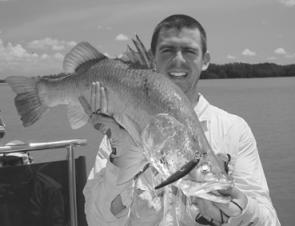Fishing tropical areas that have limited access, such as the Cape and Gulf, requires a basic knowledge of the conditions that prevail at different times of the year. The most important consideration is the ‘wet’ season; heading off north before it has ended can mean a lot of heartache and disappointment, even to the adventurous.
It’s a fairly safe bet most years that by the beginning of April, the wet has just about run its course. There have been seasons when road access has been very difficult up until mid-May, but that is the exception rather than the rule.
Given that the 05/06 wet season has been below average and rain has been patchy, getting to places like Weipa and even Bamaga should be possible in early to mid April this year. Just be sure to drive with extreme care as washouts and boggy sections will still be prevalent and maintenance crews will take some time to reach the more remote stretches.
However, there are advantages in being part of the first wave of anglers getting to remote locations after the wet. For a start, these areas have been, at worst, only lightly fished during the past four to five months, so the fish haven’t seen a lure or bait for quite some time and should be very hungry. The wet also flushes the creeks and rivers, resulting in heaps of food for the marine food chain. It’s one of the most exciting times of the fishing season, often called the ‘run-off’.
Barramundi are usually the prime target of those anglers making the effort to get to the more out-of-the-way areas during the run-off. Prime time is the bottom half of the larger tides, with the action divided between the last half of the ebb and the first couple of hours of the flood.
The most likely spots usually feature a small side creek or gutter running dirty water into the main stream. Baitfish try to shelter under the dirty water as the tide falls and forces them out of the shelter of the flats and mangroves.
The predators work the edges of the dirty water and most strikes come in that last metre or so of the colour transition. Often the dark ‘fresh’ inflows float on the denser saltwater of the mainstream, creating a situation where the bait are at the surface and the barra feeding from underneath.
Snags at this time of year will hold barra, mangrove jack, estuary cod, pikey bream and juvenile groper. Drains along the mud and sandflats will fish best for barra, king threadfin salmon and queenfish.
In the channels and holes, the estuaries are usually alive with species like blue salmon, grunter, fingermark, trevally and sometimes black jewfish but, if you are using bait, be ready to land plenty of catfish! Baitfish often congregate at strategic points attracting heaps of queenfish and the occasional golden and tea leaf trevally.
Sometimes, the amount of wet season run combined with the prevailing tides will cause some estuarine areas to fish much better than others. As a general rule, the lower end of the rivers will fish the best so, if upstream fishing is slow, try targeting the downstream reaches.
The beaches and headlands are also at their most productive at this time of year. You’ll encounter the usual players like barra, mangrove jack, estuary cod, queenfish and king salmon, and there’s also the chance of a blue salmon, giant herring, coral trout, golden trevally, triple-tail and even permit (snub-nosed dart) at this time.
So those prepared to do the planning and preparation to get in early (provided mother nature doesn’t spoil the party) can find April on the Cape one of the best months of the entire year. Charter clients are well aware of this fact – guaranteeing a spot in April usually means booking 12 months ahead, at least!
The vast majority of anglers out there don’t know just how close we all came to losing our rights to fish!
The Australian Democrats are in the process of introducing a bill into federal parliament that has the potential to severely restrict, even prohibit, the right to fish recreationally. A few of the Howard Government heavies, including former fisheries minister Macdonald, have said it won’t see the light of day.
But just think back to the last Senate election: if the Queensland Green candidate had beaten the National Party incumbent Barnaby Joyce, the Democrats’ anti-fishing bill would be going through! And why did Mr Joyce get elected over his Green opponent? 30,000 crucial votes pushed him over the line, votes that came from The Fishing Party (Qld).
Without the efforts of a small band of concerned fishers, primarily based in the Proserpine/Airlie Beach area with almost no support from industry, we’d now all be up a certain creek without a fishing rod.
But we’re not out of it yet. There are well-funded forces at work that are determined to shut rec fishing down altogether, and have even asked the commercial fishing industry for their support. We are being hammered with Marine Protected Areas that are the result of back door political deals, and the public consultation process has proved to be a farce.
The fact is, if you or your kids want to be able to go fishing in 10 years’ time, you need to support The Fishing Party. If any of you retailers/boat builders out there want to still be in business in 2015, now is the time to act.
Kevin Collins and The Fishing Party (Qld) mob are working towards running candidates in the upcoming state election as well as the next senate clash, but their time and meagre resources can only do so much. New branches and members are signing up but they still need more, lots more.
Every fisher in Australia is in their debt! It’s about time we helped out.
[CAPTION]
1. Barra like this beauty are very active during the run-off in April.
Reads: 1080




